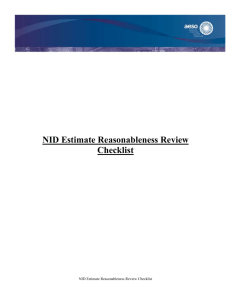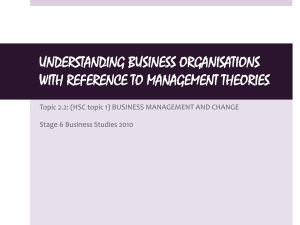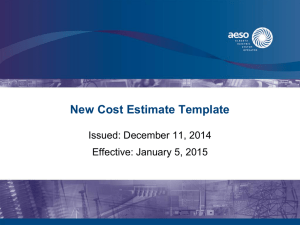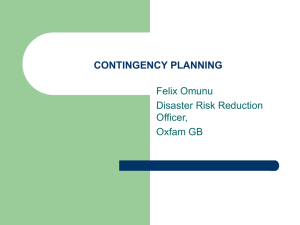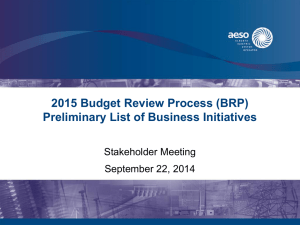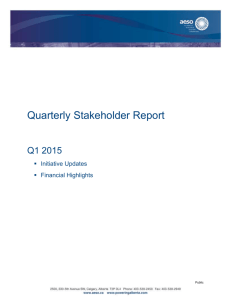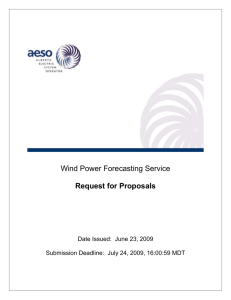ISO Rules 9.1 Transmission Facility Projects
advertisement
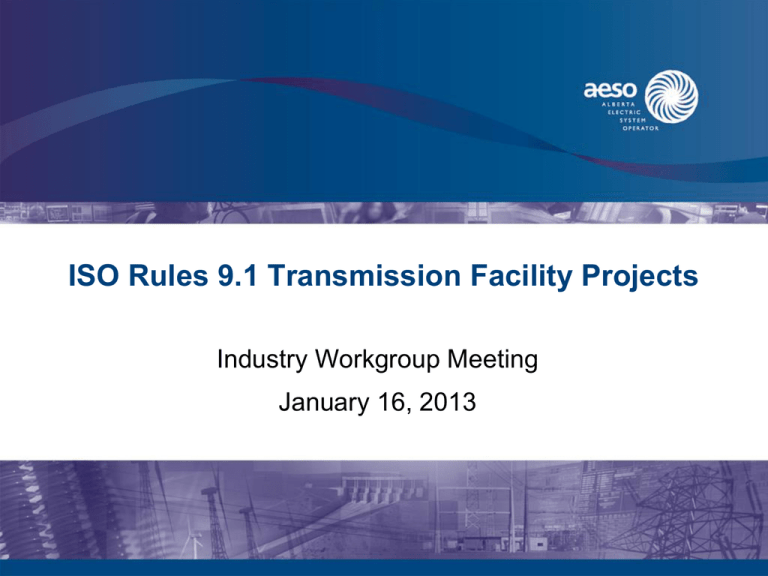
ISO Rules 9.1 Transmission Facility Projects Industry Workgroup Meeting January 16, 2013 Agenda • Welcome and Introductions • Objective for this module (NID and PPS cost estimates) • Workgroup meeting logistics • Overview of NID and PPS activities for cost estimating purposes (led by ATCO and AltaLink) • Review and discuss terms and proposed concepts/changes • Next steps 2 Working Group Members • ADC – Colette Chekerda • AESO – Evelyn Kelly, Fred Ritter, Rob Senko, Bill Strongman, Kelly Yagelniski • ATCO Electric – Natalie Bunting, Steve Ambeault • AltaLink – Darcy Fedorchuk, Gord Chalk, Janette Yearsley • ENMAX – Shiv Kumar, Mike Wong, Stan Danko • EPCOR – Suresh Sharma, Travis Robinson • IPCAA – Jake Cheng • Similan Consulting Inc.– Jana Mosley • Suncor – Baly Farmahan • TFCMC – Henry Yip • TransAlta – Anirban Bosu 3 Objective Prepare required changes to: ISO Rule 9.1.2; associated information documents; templates; or business practices to improve the quality and accuracy of cost estimates and enable the AESO: • to appropriately evaluate alternatives for potential transmission solutions to address a Need; • to enable cost estimate “reasonableness” assessments and project scope reviews to support TFO FA filings; and • to provide quality and enhanced transparency of cost reporting to the AESO’s stakeholders. 4 Workgroup Meeting Logistics Wednesday January 30, 2013 - Edmonton Wednesday February 20, 2013 - Calgary Wednesday March 13, 2013 - Edmonton Wednesday March 27, 2013 - Calgary Wednesday April 10, 2013 - Edmonton • 10:00 a.m. – 3:00 p.m. • Alternate between Calgary and Edmonton – Can the Edmonton meetings be hosted by ATCO or EPCOR? • Conference call capability 5 Roles and Expectations • Workgroup members – Attend all meetings or fully brief alternates – Obtain feedback from your organization with regard to all discussion items • AESO – Organizes and leads the meetings – Posts the presentation on the AESO website following each meeting • No meeting minutes prepared or posted – Makes the final determination on changes to ISO rules, information document, template and business practice – AESO posts a summary of proposed changes on the AESO website for industry 6 Overview of NID and PPS activities • Discussion led by – ATCO Electric – Altalink 7 Terms for Review • Baseline Cost Estimate – Accuracy – Scope Change • Assumptions • Contingency • Facility Costs – Material Costs – Labour Costs – Turn-key Costs • Non-Facility Costs – Distributed Costs – Owners – Other Costs • Escalation 8 Terms for Review Defined terms from ISO Rules 9.1.2 TFO Obligation to Provide Estimates and Proposals: • NID Estimate means a document to be completed substantially in the form of the “Needs Application Cost Estimate” posted by the ISO on its website. • Project means the project generally described as any one of the following: (i) the means or manner by which a constraint or condition affecting the operation or performance transmission system could be alleviated as identified in a NID approved by the EUB pursuant to s. 34(3) of the Act; (ii) the request for system access service pursuant to s. 5(5)(b) of the TR; (iii) all the transmission facility proposals referred to in s. 35(1)(a) of the Act with respect to a specific approved NID; or (iv) the “transmission line”, as defined in the HEEA, which has been approved by the EUB pursuant to the HEEA. 9 Terms for Review Defined terms from ISO Rules 9.1.2 TFO Obligation to Provide Estimates and Proposals: • Service Proposal means a document to be completed substantially in the form of the "Proposal to Provide Service" posted by the ISO on its website. • Service Proposal Estimate means a document to be completed substantially in the form of the “Service Proposal Estimate” posted by the ISO on its website. 10 Base Line Cost Estimate • Interpretation: – The $100M becomes the project baseline cost at the NID estimate stage once accepted by the AESO, and – It is understood and accepted that the actual project costs could vary between $70M and $130M 11 Base Line Cost Estimate • Interpretation: – The baseline cost is adjusted to $105M at the PPS stage once accepted by the AESO, and – It is understood that the actual project costs could vary between $94.5M and $126M – The AESO does not reconfirm the NID preferred alternative because the PPS estimate accuracy levels are within the +/-30% accuracy levels of the NID estimate – If the PPS estimate accuracy levels are outside the +/-30% accuracy levels of the NID estimate then the AESO must reassess the preferred alternative which could lead to: • Requesting the TFO to perform further work on the PPS; or • Accepting the PPS; or • Declining the PPS and re-starting the project. 12 Base Line Cost Estimate • Interpretation: – The baseline cost is adjusted to $110M at the PPS stage once accepted by the AESO, and – It is understood that the actual project costs could vary between $99M and $121M 13 Base Line Cost Estimate • Base line cost estimate includes: – Project cost, plus – Contingency, plus – Escalation • The base line is prepared in current dollars – The cost variance is the difference between the base cost/adjusted base cost and actual costs • For discussion: – Is there a need to formally define the base line cost? – Is it sufficient to provide an explanation in the Information Document? 14 Assumptions, Contingency, Scope Change 15 Assumptions, Contingency, Scope Change 16 Assumptions • Assumptions include items such as: – Length of line – Geotechnical conditions – Outages can be accommodated when needed – Lack of validation of earthwork quantities – Construction contractor availability and bid price – Pipeline and environment mitigation – River, high-way, line crossings – Use of a helicopter 17 Assumptions • Assumptions do not items such as: – Scope changes – Design criteria change – Legislative change – Extraordinary events (such as major strikes, natural disasters,) • For discussion: – Should a checklist of assumptions be developed for consideration on every project so there is consistency 18 Contingency • Contingency: – Stems from assumptions; assumptions lead to a risk assessment which could result in the need for a contingency amount – Contingency is included in the base line cost estimate – Allows for items such as conditions or events for which the state, occurrence, or effect is uncertain and that experience shows will likely result in additional costs • For discussion: – Is there a need to formally define contingency? – Is it sufficient to provide an explanation in the Information Document? – Should there be an threshold associated with contingency, i.e. • Cannot be more than X% of the base line cost 19 Scope Change • A scope change is: – Functionality/costs not contemplated in the project scope and translated into the baseline cost or contingency • For discussion: – Is there a need to formally define scope change? – Is it sufficient to provide an explanation in the Information Document? 20 Facility and Non-Facility Costs • Facility Costs – Labour – engineering, site preparation and survey, construction, commissioning – Material - by component • Non-Facility Costs – Owners Costs - PPS, FA, land – Distributed Costs – procurement, project management, construction management, contingency – Other Costs – AFUDC, E&S • For discussion: – Is there a need to formally define distributed costs? – Is it sufficient to provide an explanation in the Information Document? 21 Distributed Costs • Distributed costs includes: – Procurement - the labour costs required in the purchasing of project materials – Project management - labour required to manage projects as well as the partial cost of building space, utilities, etc – Construction management (labour only) – Warehouse, yard, (include in distributed costs or elsewhere?) – Logistics – camp and office (include in distributed costs or elsewhere?) – Helicopters, lay down yards (include in distributed costs or elsewhere?) – Escalation • Suggest removing from distributed costs and include as a separate line item – Contingency • Suggest removing from distributed costs and include as a separate line item • For discussion: – Is there a need to formally define distributed costs? – Is it sufficient to provide an explanation in the Information Document? 22 Owners and Other Costs • Owners costs include: – Preparing the cost estimates (NID and PPS) • Includes the labour related to any engineering required to prepare the cost estimate • Includes the labour related to preparing the PPS Proposal (word document) – Preparing the facilities application (includes AUC 007 requirements, i.e. PIP) – Regulatory proceeding associated with facilities application – Land costs • For discussion: – Is there a need to formally define distributed costs? – Is it sufficient to provide an explanation in the Information Document? 23 Owners and Other Costs • Other costs include: – Allowance for funds used during construction (“AFUDC”) – Engineering and Supervision • This is an AUC approved percentage which is applied to projects • Includes costs such as warehousing, accounting, fleet, office space, project management costs that are not specific to a project, supervision and engineering not specific to a project • It does not include costs that can be allocated directly to a project • For discussion: – Is there a need to formally define distributed costs? – Is it sufficient to provide an explanation in the Information Document? 24 Labour and Material Costs • Labour Costs – engineering, site preparation, survey, brushing, right of way preparation, construction, commissioning, installation, minor tools to support construction, rental of equipment and tools, stringing a conductor – Internal – Contractor • Material Costs – includes only the costs for the material, no labour associated with procuring the materials (includes FOB) • Turn-key – some project costs are turn-key where both labour and material are consolidated – Converter station –material and installation – Typically third party • For discussion: – Is there a need to formally define turnkey, labour and material costs? – Is it sufficient to provide an explanation in the Information Document? 25 Escalation • Escalation includes: – Changes in the cost or price of specific goods or services in a given economy over a period specific to an item or class of items (not as general in nature). – Driven by changes in technology, practices, and particularly supply-demand imbalances that are specific to a good or service in a given economy. – Transmission project costs are estimated using current dollars – Escalation is used to allow for increases in the cost of material and labour during the project time period; escalate current costs into the future, not risk of labour availability (contingency) • For discussion: – Can all TFOs use an agreed upon index for purposes of escalation? – If so, what would this index be? 26 NID Cost Estimate – Valid Time Period • For discussion: – Is there a need to establish a consistent time period regarding validity of the NID cost estimate? – If so, what is the time period? – Does this time period need to be set out in a rule? – What impact, if any, does this have on the preparation of the NID cost estimate? 27 ISO Rules 9.1 Terms • NID Estimate • Project • Service Proposal • Service Proposal Estimate • Questions for discussion: – Is there a need to update these definitions to improve the quality and accuracy of cost estimates? 28 Next Steps • Discuss the “discussion items” within your organizations – Bring back organizational views to the January 30 meeting • Alignment with proposed changes or alternate recommendations 29 Thank you
